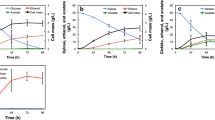Abstract
Ethanol inhibition of glucose catabolism in Zymomonas mobilis was investigated using 31P NMR spectroscopy in vivo and of perchloric acid extracts from cell suspensions incubated with 0, 5 and 10% (w/v) ethanol. In vivo 31P NMR experiments revealed slower glucose utilization and decreased levels of nucleoside triphosphates in the presence of 10% ethanol as compared to controls. Using 31P NMR spectroscopy of perchloric acid extracts, intracellular accumulation of 3.4 mM 3-phosphoglycerate was found when 10% ethanol was present in the medium. No accumulation of this metabolite occurred in cells incubated with 0 and 5% ethanol. Enzyme assays confirmed that phosphoglycerate-mutase and enolase were inhibited 31 and 40%, respectively, in the presence of 10% ethanol in the test system. Therefore, under the conditions used the decrease in the fermentative activity of Z. mobilis at high ethanol concentrations is due to inhibition of phosphoglycerate-mutase and enolase.
Similar content being viewed by others
Abbreviations
- KDPG:
-
2-keto-3-deoxy-6-phosphogluconate
References
AlgarEM, ScopesRK (1985) Studies on cell-free metabolism: ethanol production by extracts of Zymomonas mobilis. J Biotechnol 2: 275–287
BarrowKD, CollinsJG, NortonRS, RogersPL, SmithGM (1984) 31P Nuclear magnetic resonance studies of the fermentation of glucose to ethanol by Zymomonas mobilis. J Biol Chem 259: 5711–5716
BergmeyerHU, BergmeyerJ, GrasslM (1984) Methods of enzymatic analysis, vol 2. Verlag Chemie, Weinheim, pp 182–183
BradfordMM (1976) A rapid and sensitive method for the quantitation of microgram quantities of protein utilizing the principle of protein-dye binding. Anal Biochem 72: 248–254
BringerS, FinnRK, SahmH (1984) Effect of oxygen on the metabolism of Zumomonas mobilis. Arch Microbiol 139: 376–381
CareyVC, IngramLO (1983) Lipid composition of Zymomonas mobilis: effects of ethanol and glucose. J Bacteriol 154: 1291–1300
DenHollanderJA, UgurbilK, BrownTR, ShulmanRG (1981) Phosphorus-31 nuclear magnetic resonance studies of the effect of oxygen upon glycolysis in yeast. Biochemistry 20: 5871–5880
FeldmannSD, SahmH, SprengerGA (1992) Pentose metabolism in Zymomonas mobilis wild type and recombinant strains. Appl Microbiol Biotechnol 38: 354–361
HermansMAF, NeussB, SahmH (1991) Content and composition of hopanoids in Zymomonas mobilis under various growth conditions. J Bacteriol 173: 5592–5595
IngramLO, ButtkeTM (1984) Effects of alcohols on microorganisms Adv Microb Physiol 25: 253–300
KirkK, RaftosJE, KuchelPW (1986) Triethyl phosphate as an internal 31P NMR reference in biological samples. J Magn Reson 70: 484–487
LeeKJ, SkotnickiML, TribeDE, RogersPL (1980) Kinetic studies on a highly productive strain of Zymomonas mobilis. Biotechnol Lett 2: 339–344
Loureiro-DiasMC, SantosH (1990) Effects of ethanol on Saccharomyces cerevisiae as monitored by in vivo 31P and 31C nuclear magnetic resonance. Arch Microbiol 153: 384–391
MillarDG, Griffiths-SmithK, AlgarE, ScopesRK (1982) Activity and stability of glycolytic enzymes in the presence of ethanol. Biotechnol Lett 4: 601–606
NegeleinE, NollF (1984) d-Glycerate 1,3-bisphosphate. In: BergmeyerHU, BergmeyerJ, GrasslH (eds) Methods of enzymatic analysis, vol 6. Verlag Chemie, Weinheim pp 542–546
OsmanYA, IngramLO (1985) Mechanism of ethanol inhibition of fermentation in Zymomonas mobilis CP4. J Bacteriol 164: 173–180
OsmanYA, ConwayT, BonettiSJ, IngramLO (1987) Glycolytic flux in Zymomonas mobilis: enzyme and metabolite levels during batch fermentation. J Bacteriol 169: 3726–3736
RogersPL, LeeKJ, SkotnickiML, TribeDE (1982) Ethanol production by Zymomonas mobilis. Adv Biochem Engin 23: 37–84
RottenbergH (1979) The measurement of membrane potential and delta pH in cells, organelles, and vesicles. In: FleischerS, PackerL (eds) Methods in enzymology, vol 55. Academic Press, New York, pp 547–569
ScopesRK, Griffiths-SmithK (1984) Use of differential dye-ligand chromatography with affinity elution for enzyme purification: 6-phosphogluconate dehydratase from Zymomonas mobilis. Anal Biochem 136: 530–534
ScopesRK, TestolinV, StoterA, Griffiths-SmithK, AlgarEM (1985) Simultaneous purification and characterization of glucokinase, fructokinase and glucose-6-phosphate dehydrogenase from Zymomonas mobilis. Biochem J 228: 627–634
SwingsJ, DeLeyJ (1977) The biology of Zymomonas. Bacteriol Rev 41: 1–46
UgurbilK, ShulmanRG, BrownTR (1979) High-resolution 31P and 13C nuclear magnetic resonance studies of Escherichia coli cells in vivo. In: ShulmanRG (ed) Biological applications of magnetic resonance. Academic Press, New York, pp 537–589
Author information
Authors and Affiliations
Rights and permissions
About this article
Cite this article
Strohhäcker, J., de Graaf, A.A., Schoberth, S.M. et al. 31P Nuclear magnetic resonance studies of ethanol inhibition in Zymomonas mobilis . Arch. Microbiol. 159, 484–490 (1993). https://doi.org/10.1007/BF00288598
Received:
Accepted:
Issue Date:
DOI: https://doi.org/10.1007/BF00288598




